

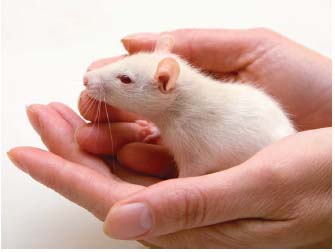
Before bringing your rat home for the first time, be sure everything—and everyone—is properly prepared for the newcomer.
BEN’S HOMECOMING SHOULD BE PREPLANNED. RATS are often an impulse purchase, but as you’ve picked up this book, I’m betting you want your relationship with Ben and Ira to last. Make the transition as comfortable and as stress free as possible, and you’ll soon be ready to start training.
Part of your planning involves making sure you can afford the necessary supplies and equipment of rat ownership. Rats may not cost as much to own as other pets do, but you should be ready to dole out some funds for appropriate housing, vet care, and healthy food. It can cost upward of $300 per year to feed each rat and more than $100 for a good cage. The cost of bedding can also add up, especially if you buy commercial brands. Even routine veterinary checkups can run upward of $50 per year; caring for a rat with chronic health issues will cost much more, as many veterinarians consider rats exotic pets that require specialized services.
Regardless of your training intentions, by bringing Ben and Ira into your home you are taking them away from their family and friends. Granted, if you have purchased your rat at a pet shop, this probably happened before on some level. If you are adopting your rat at a shelter, it has probably adjusted to this trauma. But if you are obtaining your rat from a breeder, you can be certain that Ben and Ira have known no rats other than their families.
Rats quickly acclimate to new homes, but it should be done in a manner that minimizes undue stress and thus any resulting behavioral abnormalities or physical illness.
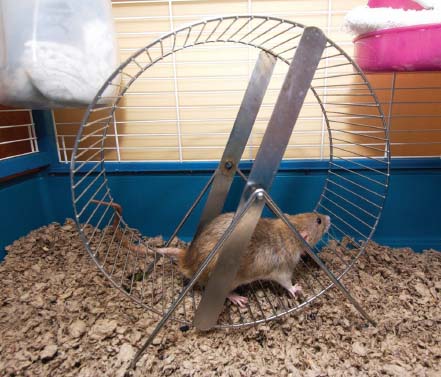
A wheel will provide your pets with hours of enjoyment, but avoid wire-runged models, as these could possibly lead to injury.
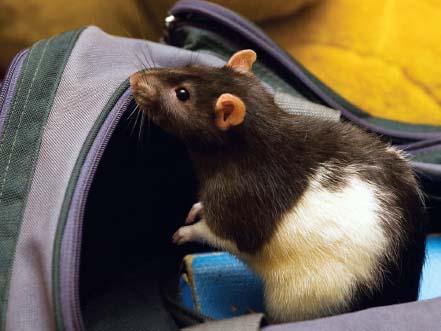
Are we there yet? Taking your new pet home in a soft carrier may not provide the security he needs—plus, remember those sharp teeth!
Before you take your rats home, consider their traveling arrangements. Dropping Ben into your pocket may be fine when he is in your home and already familiar with family, friends, and surroundings, but this is not a good idea on the first day. You can be certain that your rats will be anxious. Arrange travel conditions so that they add as little stress as possible—you’ll be helping to make the adjustment to the new environment as smooth as can be.
Since Ben and Ira’s homecoming will be a planned event, acquire and bring with you a proper, heavy-duty plastic or metal cage when you pick them up. Allowing the sales associate to place your rats in a small cardboard box is a bad idea. Rats chew, especially when stressed. Ben and Ira will chew their way right out of the box and have a free-for-all in your car in no time.
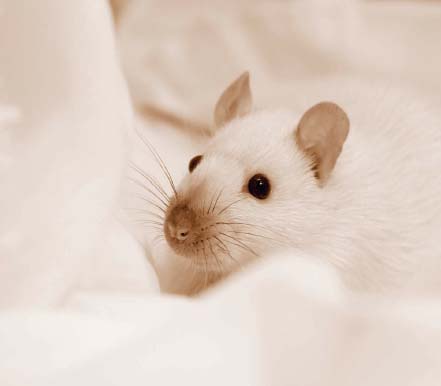
After all the excitement of moving, Ben may want to chill out for a while. Later, he will enjoy searching for hidden treasure in his blankets and sheets.
Your small travel cage should have comfortable bedding but no food or water, as this will only lead to wet messes. If you have an old piece of clothing such as a sweatshirt, cut off the sleeve and place this in the travel cage. This not only offers the rat a place to hide but also gets him used to your scent. Secure the cage in the backseat or enlist a passenger to hold the cage on his or her lap. Never drive with the rats on your lap.
The moment you arrive home, place Ben and Ira directly into their new, prepared abode, options for which are discussed in detail in chapter 3. There should be liberal offerings of food and water, clean bedding, and a hideaway where they can rest after all the commotion.
Allow Ben and Ira at least a day before you begin handling them and getting them used to you. Your rats need time to recover from the stress of leaving everything familiar, traveling to your house, and encountering the new digs. Children in the house will no doubt be excited to see the new pets and eager to hold the rats, but please don’t allow this just yet. The commotion will further tax your animals, and they might bite from fear. Mostly, they’ll just want to hide in a dark place until they settle in.
When a day or two has passed and everyone is relaxed, instruct children to pick up Ben and Ira and hold them gently but securely, without squeezing the poor creatures. Proper handling will help your rats adjust to their new family faster. Be certain to supervise all interactions between your rats and children.
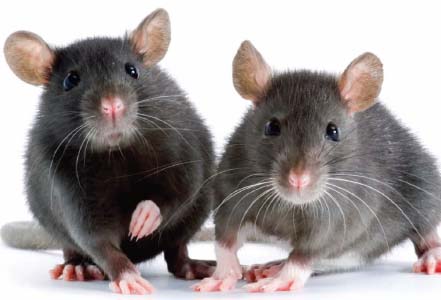
Ben and Ira require close supervision around children and other house pets.
If Ben and Ira are your only rats, then it should be easy for them to adjust to their new surroundings. However, if your single rat is coming into a home where there is an existing colony, you’ll need to make appropriate preparations, allowing Ira to establish himself without fear of fighting among the group.
Before you bring your new rat home, prepare two habitats: one for the main colony and one as a temporary home for your newcomer. As you most likely already have a temporary enclosure for cleaning days, simply clean both habitats thoroughly so that the colony’s scent is subdued. Giving the colony cage a really good cleaning reduces any scent-marking, making the new cage a more welcome home for Ira.
Place the habitats close together on the same level. If you use aquariums, you need not worry about being too close. But if you have wire cages, make certain that the rats are close enough to see and smell each other but not close enough to touch noses.
When your rats no longer strain their noses through the cage or partake in staring contests, it is time to get them together. The best place for this is neutral territory, somewhere that does not carry the smell of any colony member. Many rat experts suggest a bathtub for this meeting, as it is free of rodent scent, has nothing that can injure the animals, and is easy to clean. Another way to make the meeting relatively stress free is to place a drop of vanilla flavoring on the top of each rat’s head. This gives the rats the same scent, making it more difficult to discern who the newcomer might be. Remember to take these steps very slowly—rats can be quite pugnacious if they feel threatened!

Getting your rats to “play nice” will require your patience and encouragement.

Bathtubs provide a safe, sanitary, scent-free neutral ground for rodent introductions.
Another great way to introduce your rats is to make them irresistible to each other. Take some vanilla or butterscotch pudding and smear a tiny dab on them. Then place them in the tub together. They’ll be so busy licking and grooming both themselves and each other that they’ll be friends in no time.
If you have several rats that need to meet a new rat, do so one at a time. Give each rat a chance to meet the new colony member alone. When all have met Ira, place two of the most accepting rats in with him. As they calm down and begin grooming each other, you can add a third colony member. Continue in this manner until the colony is one entity—there are no outsiders.
Once everyone is on a first-name basis, take the rats to their play area. This can be a tabletop or your lap. Be certain to keep a close eye on them. If any fighting occurs, separate the rats immediately and go back to square one with the individual cages and the entire bathtub scene. If everything goes well, they can all be returned to the main colony cage when playtime is over.
There may be a few scuffles at first as dominance is established within the colony. Rats instinctively establish dominance by forcing the newcomer to roll over and pinning him on his back for a few seconds. If Ira does not fuss, he’ll be allowed to move away in short order. However, if he tries to fight back, you can expect some serious aggression and should not try to get the rats together so soon.
Initially, the pecking order is established through fairly frequent pushing around. The first encounters tend to be the worst, and they decrease in both intensity and frequency as Ira is accepted into the colony and learns his place within the hierarchy.
If you find that you have several male rats that tend to fight a lot, try neutering them. This often takes care of their aggression toward one another, but keep them separated for a couple of months, as it will take that long for the hormones to be eradicated from their systems.
Rats are omnivores, like us: they eat both meat and vegetables. In the wild, they’ll eat anything. This anything-goes diet is one reason why the rat is so successful in almost any environment. However, because rats have a barrier between their esophagus and stomach, they cannot vomit the way humans do after eating something toxic. Instead, rats’ acute senses of smell and taste help them avoid poisonous substances; when they come across something new, they eat only a small amount until they establish that it isn’t poisonous. If it does induce unpleasant results, they quickly learn to identify and avoid it in the future. Keep this in mind when introducing Ben and Ira to new foods. Just because they don’t gorge themselves right away doesn’t mean they won’t do so at a later time. They’re just testing it first.
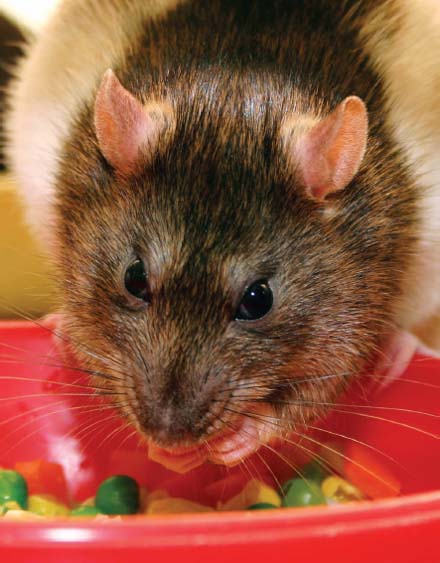
Rats like variety, but there are some items you should steer away from for health reasons, just as with people.
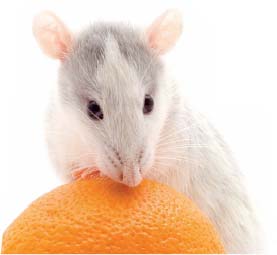
A little citrus may help boost your female rats’ resistance to illness—but play it safe and toss the peel.
Most people buy whatever rat food they can find at a pet shop. While most rat food is fairly nutritious, it doesn’t contain everything that Ben and Ira need in order to live long, healthy lives. The grains are processed, leaving fewer vitamins and minerals, and many products contain preservatives and food coloring to make them more appealing to us human buyers.
Lab blocks and seed diets contain too much corn, which can be both uncomfortable (as it can produce too much gas) and unhealthy as sole sources of nutrition. Debbie Ducommun, author of Rats: Practical, Accurate Advice from the Expert, suggests feeding your rat a diet consisting of 80 percent fortified commercial mix and 20 percent fresh fruits and vegetables.
On her Web site, www.ratfanclub.org, Ducommun also offers a recipe for a homemade rat diet. This includes fruit, vegetables (organic is always best), beef liver, oysters, sweet potatoes, cereal, molasses, and rice. These ingredients give the rat a well-rounded diet, much like it would consume in the wild. Receiving such good nutrition will possibly extend your rat’s life and reduce the frequency of visits to the veterinarian for illnesses. Onesta Organics even makes a wonderful organic whole food supplement for rats (www.onestaorganics.com).
Be aware that some key foods will ward off illness or help your rat recover from a virus. For rats that have a family history of strokes, feeding celery, parsley, and prunes can reduce the incidence of this malady. Female rats can be fed oranges or orange juice, but these foods are not recommended for male rats, which can develop kidney damage or cancer from orange peel oil in the presence of a specific kidney protein. When trying to help your rat recover from a virus, or to boost resistance to viral infection, try feeding cranberries, strawberries, bananas, small amounts of garlic, raspberries, and mustard. How about a cup of green tea for that cold? Yes, rats benefit from a bit of tea as well.
Older rats, which may be prone to arthritis, can be fed cloves, ginger, garlic, and dates to help them maintain joint fluid and reduce inflammation. A sprinkle of whole-grain, vitamin-enriched breakfast cereal flakes is a source of antioxidants that help reduce cell damage and improve resistance to infection.

Rodents fed a diet that includes sunflower seeds often pick them out and leave the rest, which leads to an unbalanced, fattening diet.
Anything Doesn’t Always Go
CERTAIN EVERYDAY FOODS ARE KNOWN TO HAVE HARMFUL, even fatal, effects on rats, so do your research on rat nutrition ahead of time. Debbie Ducommun warns about the following items on her Web site, www.ratfanclub.org:
 RAW DRY BEANS OR PEANUTS: These contain antinutrients—substances that interfere with the absorption or utilization of nutrients—and natural toxins that can destroy your rat’s vitamin A and the enzymes needed to digest his food, namely the starches and proteins. This food can also cause a rat’s red blood cells to clump.
RAW DRY BEANS OR PEANUTS: These contain antinutrients—substances that interfere with the absorption or utilization of nutrients—and natural toxins that can destroy your rat’s vitamin A and the enzymes needed to digest his food, namely the starches and proteins. This food can also cause a rat’s red blood cells to clump.
 GREEN BANANAS: While ripe bananas have helpful healing properties, the green bananas inhibit starch-digesting enzymes. Make certain that you feed only yellow bananas.
GREEN BANANAS: While ripe bananas have helpful healing properties, the green bananas inhibit starch-digesting enzymes. Make certain that you feed only yellow bananas.
 GREEN POTATO SKIN AND EYES: These contain solanine, which is a toxin.
GREEN POTATO SKIN AND EYES: These contain solanine, which is a toxin.
 INSECTS: I advise against feeding rats anything other than grains, vegetables, and fruit. Exposure to nonregulated food items such as insects or discarded meats can sometimes be a health hazard, as they can contain parasites and carry disease.
INSECTS: I advise against feeding rats anything other than grains, vegetables, and fruit. Exposure to nonregulated food items such as insects or discarded meats can sometimes be a health hazard, as they can contain parasites and carry disease.
 RAW BULK TOFU: Bulk tofu can contain bacteria that can be fatal to your rat. Buy only the packaged raw tofu, as it’s been protected against bacteria.
RAW BULK TOFU: Bulk tofu can contain bacteria that can be fatal to your rat. Buy only the packaged raw tofu, as it’s been protected against bacteria.
You should also take care to limit the amount of nitrates in your rat’s food. Too many cause a carcinogenic condition in the rat’s stomach. Limit the amount of the following foods: corn (remember how common an ingredient this is in commercial diets?), eggplant, lettuce, radish, spinach, collard and turnip greens, beets, and celery. And, of course, no soda and candy bars. Rats may like them, but that doesn’t mean you are being kind by offering them. Just as junk food causes obesity and health issues in humans, so it does in rats. Try the yogurt treats widely available in pet shops. These are far healthier than candies.
Another consideration is your rat’s water. Tap water is normally chlorinated and fluorinated for human consumption. This is not good for your rat. In addition, if you live in an old home, your water may be traveling through old pipes made of lead, a mineral that can leach into the water with toxic effects. If you have well water, allow the water to run on cold for a minute or two before filling Ben and Ira’s water bottle. This will allow any contaminants to wash out of the pipes before you offer the water to your rat. If you are unsure of your source, it doesn’t hurt to give your rat distilled water, and it can be a great way to detoxify the system. Then you can be certain that your furry pet won’t unknowingly be poisoned. Thoroughly cleaning Ben and Ira’s water bottle every couple of days will also help reduce any mold and bacteria buildup.
This is an important topic, since Ben and Ira will be spending their lives sleeping, exercising, and eating in their cages. They’ll build nests with bedding material and often ingest particles of bedding as they nibble and play.
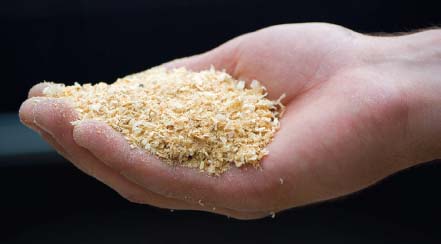
Sawdust is an option, but look for heat-treated and phenol-and dust-free varieties.
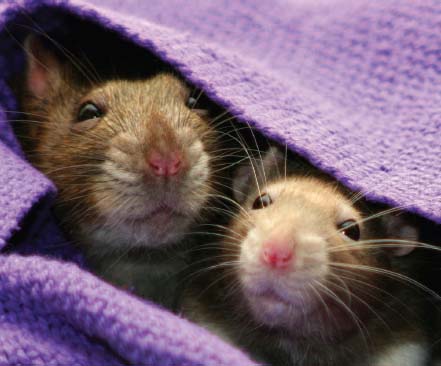
Give Ben and Ira some old, clean towels or blankets, but watch for stray threads, which can be harmful.
Most pet shops carry at least some of the more than a dozen bedding products suitable for small mammal cages. One popular choice, CareFresh, consists of short pulp fibers that look like shredded egg cartons. It is fluffy and soft and absorbs liquid pretty well, but it does not keep down odors. Another popular material, recyclable Eco-Bedding, looks like small, crinkled strips of brown paper. Some brands are made of Aspen bark or grain. Alfalfa pellets are another possibility but will likely be eaten by Ben and Ira, reducing their desire for more appropriate foods. You can use shredded paper from your shredding machine, but be certain that it contains no ink, which can be toxic to rats. Torn paper towels, tissues, or blank paper make great bedding but soil quickly, requiring more frequent cage cleaning.
Old clothing is a popular bedding but will need to be cleaned often and watched for stray threads. Ben and Ira can easily catch their feet on long threads and injure themselves. Be wary also of some of the shavings that are packaged as pet bedding. Cedar and pine shavings may contain a chemical, phenol, that might cause liver damage and respiratory illnesses in small mammals. Good pine-shaving products, such as Pet Pine and Feline Pine, have been kiln dried and offer great absorption as well as odor reduction.
While corncob bedding is becoming more popular for cat litter boxes, you might want to steer clear of this as a rat bedding. Rats are as likely to eat the material as to build a nest with it, and it’s important to remember that too much corn is not healthy for your rodent.
For a detailed discussion of the pros and cons of all currently available rat beddings, I recommend the book Training Your Pet Rat by Gerry Bucsis and Barbara Somerville. Careful research of this issue will reduce the incidence of illness and death, giving you a healthy, happy rat. A happy rat will be more eager to learn and more capable of maintaining an attention span longer than two minutes. This will make training a much smoother process.
An essential part of preparing to bring a rat into your home is finding a veterinarian who works with rodents. Look for someone who specializes in small mammals. Check local yellow pages listings, and ask for references from local veterinary clinics. It may take some legwork to locate a veterinarian qualified to work on rats, especially outside big cities, as basic veterinary training focuses on more common pets, such as cats and dogs, or on large mammals such as horses. You want someone who not only takes a special interest in working with small mammals but also attends seminars and classes regularly to stay current on treating these pets. Two organizations that can be helpful in locating a qualified veterinarian are the Rat Fan Club (www.ratfanclub.org) and the Rat and Mouse Club of America (www.rmca.org).
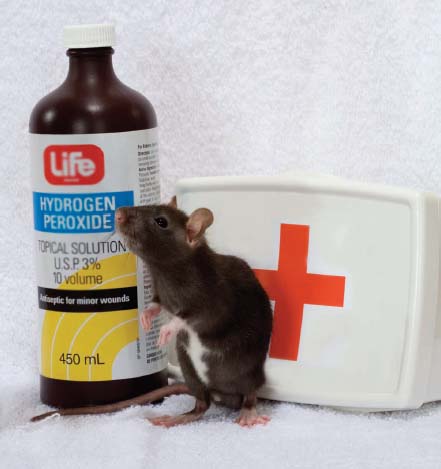
Rats need regular health care just as dogs and cats do. Look for a vet who specializes in small mammals.
The first visit to your vet should take place shortly after you acquire your rat. Your vet will perform a general examination, check Ben’s eyes and ears, palpate the abdomen, and listen to the heart and lungs. You will be asked where you purchased your rat, what you’re feeding, and what kind of bedding you use. If you have any questions about proper care and equipment, a qualified rodent vet should be able to answer them.
Next, you should consider scheduling neutering or spaying your rats between three and six months of age—sooner rather than later for a female, since she may be ready to breed by the age of five weeks. Spaying and neutering has many health and behavioral benefits beyond population control. For Sophie, it can mean prevention of both mammary and pituitary tumors, which are caused by hormonal changes when ovulation stops. In other words, it’s a side effect of rat menopause. Mammary tumors, common in females, are often benign but still require surgery, causing undue stress on Sophie’s body. A pituitary tumor is often fatal. Symptoms can range from lethargy to loss of coordination and paralysis.
A male rat should be neutered between three and four months of age to achieve the most beneficial results. These include a less oily coat, less territorial marking, a lower incidence of aggressive behavior, a reduced chance of hormone-related cancers associated with age, and lowered risk of prostate disease and kidney degeneration.
If you want your rat to live a long and healthy life, give it the medical care it needs. For further advice, see Debbie Ducommun’s Rats, which describes many of the diseases and infections common in these animals, how to recognize them, and in many cases, how to deal with them.